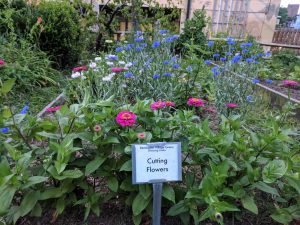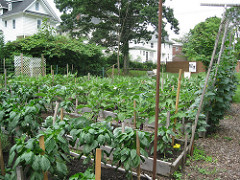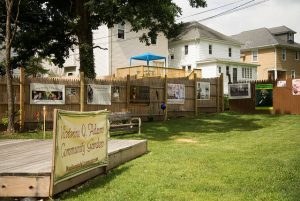- ABOUT US
- WHAT WE DO
- SPACES SERVED
Overview and map
of all spaces - RESOURCES
- GET INVOLVED
- ABOUT US
- WHAT WE DO
- SPACES SERVED
Overview and map
of all spaces - RESOURCES
- GET INVOLVED
- DONATE
Overview and map
of all spaces
Overview and map
of all spaces
By Molly McCullagh
Each garden preserved by Baltimore Green Space is unique, with its own setting and history. But they are all managed by community volunteers to benefit the wider community. This month, Johnny Shaw, Ashlie Kauffman, and Jan Mooney, three of our heroic garden leaders, share tips for getting the work done.
Ashlie manages the Remington Green Village, a garden on six house lots in the Remington neighborhood. At the Remington Village Green, gardeners take responsibility for a particular communal plot (the “tomato” plot or the “cutting flower” plot) and weed as needed; the group pitches in during weekly Friday evening workdays.
In the communal gardening system the entire garden group decides what to grow collectively, plants together, takes responsibility for weeding and watering, and shares in the yield. This makes it easier to keep the overall site well-tended – plots that become overgrown can be kept up during group workdays. However, the communal system can result in lower sense of ownership, where individuals don’t care for a communal plot as they would for their own. It also requires extra coordination to make collective decisions and communicate maintenance needs to the group.
Ashlie plans and promotes each workday over social media, sets up the meetings to plan each season, seeks new gardeners, and enforces group expectations and guidelines for the site. She also keeps track of the activities of the committee leaders who oversee events, the site, and the plants. Being a garden manager involves a lot of commitment and skill.

Johnny is the garden administrator at the Victorine Q. Adams Organic Garden, founded in 2008 by members of the 3200 Carlisle Block Association in the Hanlon Park community. The site uses a combination approach, with twenty communally managed plots and five individual plots. Individual plots allow individual gardeners to adopt and manage a plot exclusively, having control over what is grown and how the bed is maintained.
Johnny says that the combination approach was adopted at the request of the members, some of whom are new to gardening and preferred to be part of a communal garden and help out at their leisure. Others prefer to grow their own personal produce with their families.
Johnny and Robin Sheridan, the garden manager, plan the everyday garden chores, communicate plans and assignments to members, collect dues, keep records related to fertilizing and watering, seek grants, and keep financial records for the site. They maintain communication among the gardeners with monthly meetings and frequent text messages and e-mails. Communication is key; it’s amazing when garden leaders find the right combination of tools to use to keep the garden and the community love growing.

Over at the Upper Fell’s Point Community Garden, garden manager Jan reports success keeping their garden in good orderwith clear rules, shared responsibility, and plenty of communication. They use solely individual plots, with 20 individual plots on what was three house lots on E. Pratt Street. Each gardener or family maintains their own plot and pays modest dues to the garden.
As seasoned garden leaders, Jan, Johnny, and Ashlie all know that many new gardeners begin the season with great enthusiasm, but are less attentive by August, when weeds and heat are at their peak. Johnny describes one of his main challenges, on top of dealing with bugs and disease, as keeping people “motivated throughout the season.” He understands that new gardeners can need extra handholding and training about what to expect in each phase and to get them hooked.
“It is often necessary,” he says “to do the work for them as they tend to have other interests that keep them away for periods of time. When they see the yield their garden produces, they tend to become more interested.” With larger beds (over 20 square feet), Ashlie in Remington splits a plot between two new gardeners as they develop their skills. Jan will weed a gardener’s plot for them when necessary, for example if they plan to be out of town, but plots that remain untended will eventually be turned over to someone on the waitlist. Upper Fells garden has smaller plots and the seasoned gardeners support those newer to growing. Some gardeners have been with the garden since it began in 1987, and the new gardeners find mentors among the more experienced gardeners.
All the gardens have shared spaces that must be managed, such as pathways to weed, lawn to mow, fruit trees or edge plantings to tend. A garden manager either assumes these responsibilities or coordinates among gardeners to accomplish them. At Victorine, the communal spaces around each plot (the lawn, pathways, and flower beds), are maintained by a volunteer maintenance crew. The gardeners at Upper Fell’s Point meet at the beginning of the season to review the garden guidelines and sign up for tasks over the year, such as taking out the trash, turning the compost, or mowing the lawn. Each person signs up for one task for the month and is required to do four tasks over the year (although the larger tasks count for double!). Jan shares the schedule each month to keep everyone on track and follows up to give instructions for how to accomplish the tasks or to remind them if they are behind.
Community gardens are labors of love. We salute the garden managers, who do more than their share and learn to adjust to other people’s work styles and pacing. It’s important to remember that no matter what successes or failures you experience in a season, everything is trial and error, there’s no one way to do things – and there’s always next year to try it again!

Be the first to hear about exciting events, news, and opportunities.
[email protected]
(813) 530-8166
2100 Liberty Heights Avenue
Baltimore MD 21217
Facebook | Instagram | Twitter